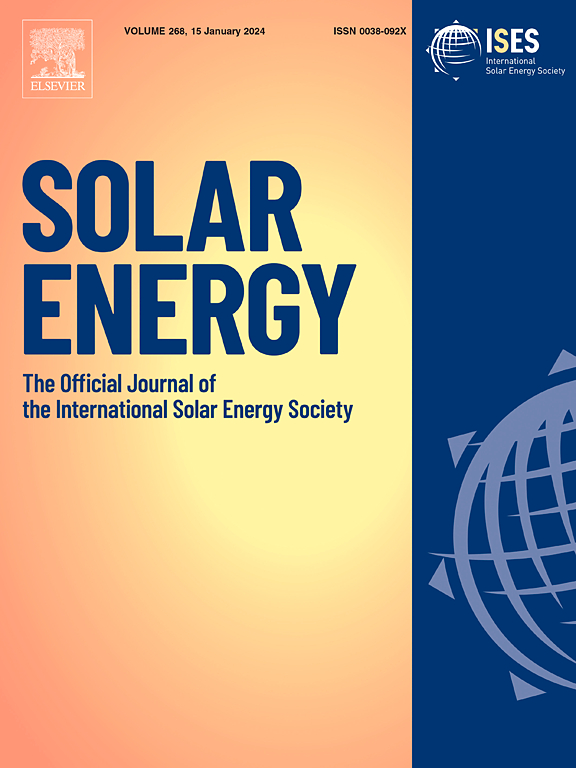基于油灰的新型可持续形状稳定相变材料的表征
IF 6
2区 工程技术
Q2 ENERGY & FUELS
引用次数: 0
摘要
相变材料(PCM)在各种被动冷却应用中越来越受欢迎,特别是在光伏(PV)热管理中。然而,当将PCM与光伏板集成时,会出现一些问题,如泄漏、PCM容器设计、倾斜角度考虑和PCM低导热性,这些都会影响整个PV热管理过程。为了解决这些问题,一种新型的可持续形状稳定相变材料(SSPCM)被用作RT-42 PCM的载体,该材料基于来自燃烧油的油灰。该材料旨在提高导热性,消除泄漏,倾斜角度问题,并需要PCM容器。本研究采用两步真空浸渍法制备了SSPCM,并利用各种表征技术对其热物理性质和稳定性进行了研究。结果表明:油灰呈球形、高孔隙结构,粒径在13 ~ 50µm之间,有利于PCM的有效吸附和分布;研究人员对油灰中不同的RT-42 PCM加载量进行了测试,结果表明,PCM的最佳加载量为总重量的40%,从而使材料稳定,无泄漏迹象。但是,超过这个百分比可能会导致泄漏问题。此外,结果证实了油灰中PCM的均匀存在,各组分之间没有发生化学反应。SSPCM的潜热为71.54 J/g,熔点为38.1℃。在45°C时,材料的导热系数从0.19 W/m·K显著提高到0.7352 W/m·K,提高了287%。为了保证材料及其性能的稳定性,进行了100次熔融-凝固循环。结果表明,该材料没有泄漏问题,潜热和导热系数也没有变化,证实了该材料的长期可靠性。为了评估SSPCM在光伏热管理应用中的实际性能,在太阳辐照下,测量了模拟光伏板的2瓦热负荷下的散热器底座的温度,并与空散热器和负载RT-42 PCM的散热器进行了比较。结果表明,在加热阶段,SSPCM最大降低了散热器温度4.7°C,有利于更快的散热,与空散热器相比,最大温差为4.2°C。本文章由计算机程序翻译,如有差异,请以英文原文为准。
Characterization of a novel sustainable shape stabilized phase change material based on oil ash for photovoltaic thermal management
Phase change material (PCM) are becoming more desired for passive cooling in various applications, especially in photovoltaic (PV) thermal management. However, several issues arise when integrating PCM with PV panels, such as leakage, PCM container design, tilt angle considerations, and PCM low thermal conductivity, which affects the overall PV thermal management process. To address these issues, a novel sustainable shape-stabilized phase change material (SSPCM) based on oil ash derived from burning oils is used as a carrier for RT-42 PCM. This material aims to improve thermal conductivity, eliminate leakage, tilt angle issues, and the need of PCM container. In this study, the SSPCM was prepared using a two-step vacuum impregnation method, and its thermophysical properties and stability were investigated using various characterization techniques. Results showed that oil ash has a spherical, highly porous structure with particle sizes ranging from 13 µm to 50 µm, enabling effective absorption and distribution of PCM. Different RT-42 PCM loadings within the oil ash were examined, and results indicated that the optimal PCM loading is 40 % of the total weight, leading to a stable material with no signs of leakage. However, exceeding this percentage may result in leakage issues. Moreover, the results confirmed the uniform presence of PCM inside the oil ash with no chemical reactions occurring between the components. The SSPCM exhibited a latent heat of 71.54 J/g and a melting point of 38.1 °C. Additionally, the thermal conductivity of the material increased significantly from 0.19 W/m·K to 0.7352 W/m·K at 45 °C, representing a 287 % enhancement. To ensure the stability of the material and its properties, 100 melting-solidification cycles were performed. Results showed no leakage issues or changes in latent heat and thermal conductivity, confirming the material’s long-term reliability. To evaluate the practical performance of the SSPCM in PV thermal management applications, the temperature of a heat sink base exposed to a 2-watt heat load mimicking a PV panel under solar irradiance was measured and compared with an empty heat sink and a heat sink loaded with RT-42 PCM. Results demonstrated that the developed SSPCM reduced the heat sink temperature by a maximum of 4.7 °C during the heating phase and facilitated faster heat dissipation, with a maximum temperature difference of 4.2 °C compared to an empty heat sink.
求助全文
通过发布文献求助,成功后即可免费获取论文全文。
去求助
来源期刊

Solar Energy
工程技术-能源与燃料
CiteScore
13.90
自引率
9.00%
发文量
0
审稿时长
47 days
期刊介绍:
Solar Energy welcomes manuscripts presenting information not previously published in journals on any aspect of solar energy research, development, application, measurement or policy. The term "solar energy" in this context includes the indirect uses such as wind energy and biomass
 求助内容:
求助内容: 应助结果提醒方式:
应助结果提醒方式:


